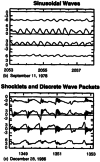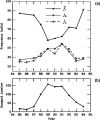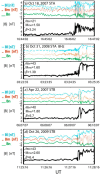From Foreshock 30-Second Waves to Magnetospheric Pc3 Waves
- PMID: 40060199
- PMCID: PMC11889074
- DOI: 10.1007/s11214-025-01152-y
From Foreshock 30-Second Waves to Magnetospheric Pc3 Waves
Abstract
Ultra-low frequency waves, with periods between 1-1000 s, are ubiquitous in the near-Earth plasma environment and play an important role in magnetospheric dynamics and in the transfer of electromagnetic energy from the solar wind to the magnetosphere. A class of those waves, often referred to as Pc3 waves when they are recorded from the ground, with periods between 10 and 45 s, are routinely observed in the dayside magnetosphere. They originate from the ion foreshock, a region of geospace extending upstream of the quasi-parallel portion of Earth's bow shock. There, the interaction between shock-reflected ions and the incoming solar wind gives rise to a variety of waves, and predominantly fast-magnetosonic waves with a period typically around 30 s. The connection between these waves upstream of the shock and their counterparts observed inside the magnetosphere and on the ground was inferred already early on in space observations due to similar properties, thereby implying the transmission of the waves across near-Earth space, through the shock and the magnetopause. This review provides an overview of foreshock 30-second/Pc3 waves research from the early observations in the 1960s to the present day, covering the entire propagation pathway of these waves, from the foreshock to the ground. We describe the processes at play in the different regions of geospace, and review observational, theoretical and numerical works pertaining to the study of these waves. We conclude this review with unresolved questions and upcoming opportunities in both observations and simulations to further our understanding of these waves.
© The Author(s) 2025.
Conflict of interest statement
Competing InterestsThe authors declare they have no financial interests. The authors have no competing interests to declare that are relevant to the content of this article.
Figures





































References
-
- Ala-Lahti MM, Kilpua EKJ, Dimmock AP, Osmane A, Pulkkinen T, Souček J (2018) Statistical analysis of mirror mode waves in sheath regions driven by interplanetary coronal mass ejection. Ann Geophys 36(3):793–808
-
- Ala-Lahti M, Kilpua EKJ, Souček J, Pulkkinen TI, Dimmock AP (2019) Alfvén ion cyclotron waves in sheath regions driven by interplanetary coronal mass ejections. J Geophys Res Space Phys 124(6):3893–3909
-
- Ala-Lahti M, Dimmock AP, Pulkkinen TI, Good SW, Yordanova E, Turc L, Kilpua EKJ (2021) Transmission of an ICME sheath into the Earth’s magnetosheath and the occurrence of traveling foreshocks. J Geophys Res Space Phys 126(12):e29896
-
- Anderson BJ, Engebretson MJ (1995) Relative intensity of toroidal and compressional Pc 3-4 wave power in the dayside outer magnetosphere. J Geophys Res 100(A6):9591–9604
-
- Anderson BJ, Fuselier SA (1993) Magnetic pulsations from 0.1 to 4.0 Hz and associated plasma properties in the Earth’s subsolar magnetosheath and plasma depletion layer. J Geophys Res 98(A2):1461–1480
Publication types
LinkOut - more resources
Full Text Sources
